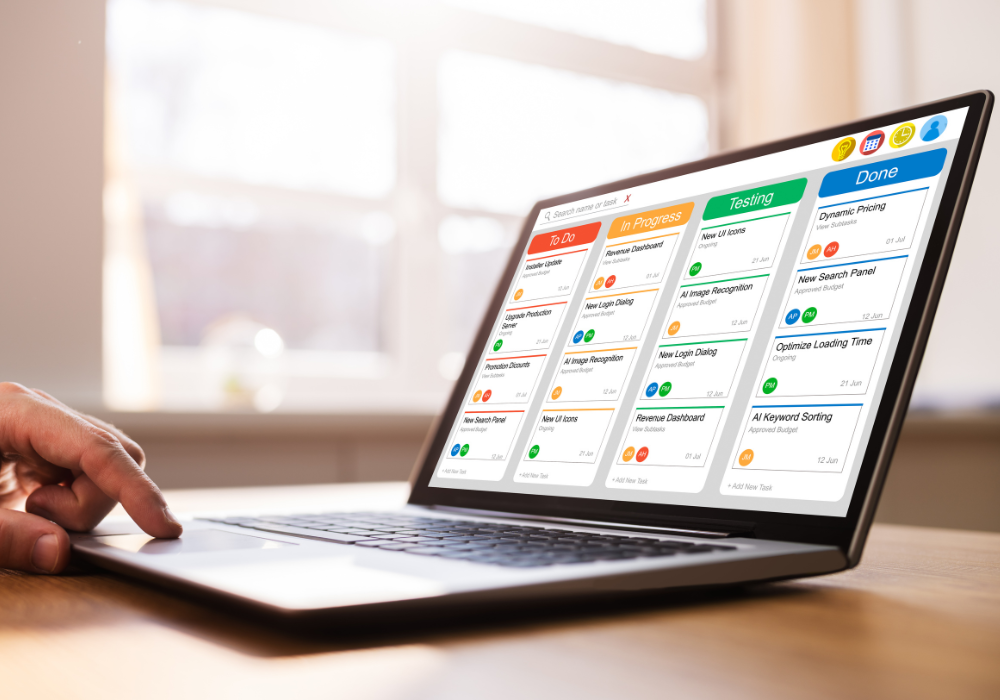A Kanban board is a visual tool within CRM software that helps manage workflows by organizing tasks, sales processes, and customer interactions on a board with movable cards. This article explores the functionality, benefits, and practical tips for using Kanban boards in CRM to streamline operations.
Why Use a Kanban Board in CRM?
Enhanced Visual Management of Tasks
A Kanban board provides a clear, visual representation of workflows, making it easy to see task statuses, identify bottlenecks, and prioritize activities.
Increased Team Productivity and Collaboration
With a shared view of all tasks and responsibilities, teams can collaborate more efficiently, ensuring everyone is aligned and work progresses smoothly.
Improved Task Organization and Workflow Optimization
By categorizing tasks into columns like “To Do,” “In Progress,” and “Done,” the Kanban board helps maintain an organized workflow, allowing team members to focus on one task at a time.
How Kanban Boards Work in CRM Software
1. Columns Represent Stages
Each column on the Kanban board represents a specific stage in the workflow, such as stages of a sales pipeline (e.g., “Leads,” “Qualified,” “Negotiation,” “Closed”).
2. Cards Represent Tasks or Deals
Cards are individual tasks, deals, or customer interactions that move across columns as they progress through the workflow. Each card contains essential information like task details, deadlines, and assigned team members.
3. Drag-and-Drop Functionality
Kanban boards allow users to easily move cards between columns with a simple drag-and-drop function, making it easy to update the status of each task in real-time.
4. Color Coding and Labels
Many CRM Kanban boards support color coding and customizable labels, helping users quickly differentiate between tasks, prioritize work, and highlight important items.
Key Benefits of Kanban Boards in CRM Software
1. Simplified Sales Pipeline Management
Kanban boards are especially useful for sales teams, as they offer a visual representation of each stage in the sales pipeline, helping teams manage leads, track progress, and focus on closing deals.
2. Real-Time Status Updates
With real-time updates, Kanban boards allow everyone on the team to instantly see the status of each task, enhancing transparency and accountability.
3. Reduced Task Overload
By breaking down tasks into manageable stages, Kanban boards help reduce overload, keeping team members focused on fewer tasks and ensuring quality over quantity.
4. Increased Focus and Efficiency
The Kanban board’s structure encourages teams to focus on one task at a time, reducing distractions and helping team members complete tasks more efficiently.
How to Set Up a Kanban Board in CRM
Step 1: Define the Workflow Stages
Identify and define each stage in your process. For example, in sales, you might create columns for “Lead,” “Contacted,” “Proposal Sent,” and “Closed.”
Step 2: Create and Organize Cards
Add tasks, deals, or customer interactions as individual cards, ensuring each card includes all necessary details, such as priority, deadline, and team member assignment.
Step 3: Use Labels and Color Coding
Customize labels and colors to highlight task categories or urgency levels, making it easier to prioritize work visually.
Step 4: Update Cards Regularly
Encourage team members to update cards and move them between columns as tasks progress, ensuring the board reflects the latest status at all times.
Step 5: Monitor and Optimize the Workflow
Review the Kanban board regularly to identify bottlenecks, assess workload balance, and optimize stages as needed to keep the workflow efficient.
 Best Practices for Using Kanban Boards in CRM Software Best Practices for Using Kanban Boards in CRM Software
1. Limit Work in Progress (WIP)
Set a cap on the number of cards allowed in each stage to prevent bottlenecks and maintain a steady flow of work.
2. Assign Clear Ownership
Ensure each task card has a clearly assigned team member responsible for moving it through the stages, promoting accountability.
3. Review the Board Daily
Hold regular team check-ins to review the Kanban board, addressing any delays, reallocating tasks if needed, and celebrating progress.
4. Utilize Automation Features
Many CRM tools with Kanban boards support automation, such as automatically moving a card when a task is completed, setting reminders, or sending notifications to assigned team members.
5. Optimize Based on Feedback
Gather feedback from the team to refine and adjust the board setup, ensuring it remains an effective and user-friendly tool.
Popular Use Cases for Kanban Boards in CRM
1. Sales Pipeline Management
Kanban boards provide a clear view of each stage in the sales process, helping sales teams focus on converting leads and closing deals.
2. Customer Support Ticketing
Support teams can use Kanban boards to track support requests, moving tickets through stages like “New,” “In Progress,” “Resolved,” and “Closed.”
3. Marketing Campaign Planning
Marketing teams can organize tasks for campaigns, from ideation through to launch, ensuring every task is accounted for and progresses smoothly.
4. Project and Task Management
Kanban boards work well for managing general project tasks, from initial planning and resource allocation to final delivery.
Conclusion
Leveraging Kanban Boards for Streamlined CRM Operations
Kanban boards in CRM software provide a powerful visual tool for managing workflows, increasing efficiency, and enhancing team collaboration. By structuring work into visual stages and moving tasks through a clear progression, Kanban boards can transform how teams manage their workflows, optimize processes, and ultimately, better serve customers. Understanding the Kanban Board in CRM Software: A Complete Guide, Understanding the Kanban Board in CRM Software: A Complete Guide |












